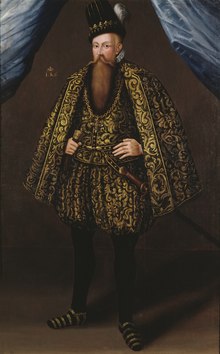
Back يوهان الثالث Arabic يوهان التالت ARZ اۆچونجو یوهان (سوئد) AZB Юхан III Byelorussian Юган III BE-X-OLD Йохан III (Швеция) Bulgarian Johan III Breton Ivan III, kralj Švedske BS Joan III de Suècia Catalan Jan III. Švédský Czech
| John III | |
|---|---|
 Portrait by Johan Baptista van Uther, 1582 | |
| King of Sweden Grand Duke of Finland | |
| Reign | January 1569 – 17 November 1592 |
| Coronation | 10 July 1569 |
| Predecessor | Eric XIV |
| Successor | Sigismund |
| Born | 20 December 1537 Stegeborg Castle |
| Died | 17 November 1592 (aged 54) Tre Kronor castle |
| Burial | 1 February 1594 |
| Spouses | |
| Issue | |
| House | Vasa |
| Father | Gustav I of Sweden |
| Mother | Margaret Leijonhufvud |
| Religion | mediating between Lutheranism and Catholicism[1] |
| Signature | |
John III (Swedish: Johan III, Finnish: Juhana III; 20 December 1537 – 17 November 1592) was King of Sweden from 1569 until his death. He attained the Swedish throne after a rebellion against his half-brother Eric XIV. He is mainly remembered for his attempts to close the gap between the newly established Lutheran Church of Sweden and the Catholic Church, as well as his conflict with and possible murder of his brother.


He was also, quite autonomously, the Duke of Finland from 1556 to 1563. In 1581 he assumed the title Grand Prince of Finland. His first wife was Catherine Jagiellon of the Polish–Lithuanian ruling family, and their son Sigismund eventually ascended both the Polish–Lithuanian and Swedish thrones.[2] He ended the Northern Seven Years' War, but instead Sweden was drawn into the 25 Years' War with Russia, where minor gains were eventually made. He worked for closer relations with Poland. John III was interested in religion and culture. During his reign, he countered the growing Lutheran tendencies of the Church of Sweden under the influence of Duke Charles, and worked for a reunion with the Catholic Church and the Pope in Rome.
John III was the son of King Gustav I of Sweden and his second wife Margaret Leijonhufvud. He was the brother of Charles IX and Magnus and half-brother of Eric XIV. He was married from October 4, 1562 to Catherine Jagiellon (1526-1583), with whom he had a daughter Anna Vasa in addition to Sigismund, and from February 21, 1585 to Gunilla Johansdotter (Bielke) (1568-1597).[2]
- ^ "was not a Lutheran": Encyclopedia of Martin Luther and the Reformation, Volume 2, p. 737
- ^ a b Harrison & Eriksson 2010, p. 391.